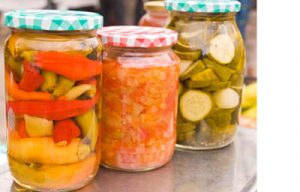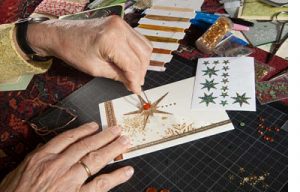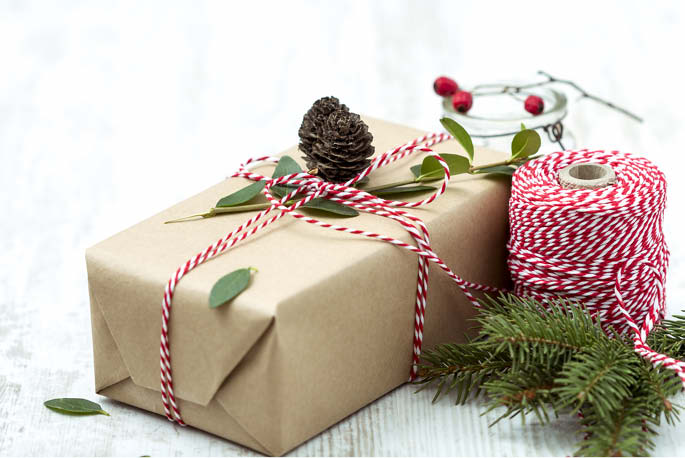Buy Less
Some holiday gifts fill a practical need and need to be bought new. But many gifts are really gestures of thoughtfulness. You can give more while spending less.

Not all gifts have to be store-bought.
You can give more while spending less by giving gifts that are personal and unique. While young children may favor the bright, shiny store-bought item, moat adults appreciate anything that shows thoughtfulness. Time to put those baking and preserving skills into action.
Donate to an ethical cause on behalf a friend or business through organisations like Oxfam, Tearfund or ChildFund where you can buy meaningful gifts that change the lives of others like drinking water or a bicycle.
Buy Smart – think ‘green’
Look for locally made gifts
Many gifts in today’s marketplace come from halfway around the world, and the impact of transportation contributes significantly to greenhouse emissions and global warming. Local craft fairs and artisan shops are a good source for gifts that come without the added costs of transportation. And gifts made locally often have a story which goes with the gift, since the artisan and the origin of the gift are known.
Choose gifts made from recycled sources
Many individuals and small businesses have developed great products using recycled materials. Supporting these businesses helps reduce the waste stream while promoting the concept of making best use of available materials.
Give ‘battery-free’ gifts
40% of all battery sales occur during the holiday season. Discarded batteries are an environmental hazard. Even rechargeable batteries find their way into the waste stream eventually.
‘Re-gifting’ is OK
There’s much discussion these days about the etiquette behind the trend to ‘re-gift’. What’s to discuss? Re-gifting makes perfect sense. If you receive something you really don’t need, look for ways you can reuse this gift by passing it on to someone who can use it. Of course, re-gifting needs to be done with care so as not to offend the original giver, but keeping a gift you don’t need is wasteful.
Sustainable practices
Buy gifts that have been produced through sustainable practices from businesses that have environmental policies in place to actively work to reduce their carbon footprint like cosmetic companies The Body Shop, Lush, and Trilogy.
Connect with Nature
Christmas is a time for giving, and a time for family. What a great opportunity to start a family tradition of giving back to the earth and instilling the values of sustainable living to your family. Start an annual, earth-friendly Christmas family tradition! It will also get you outdoors for a few hours to build an appetite for the big dinner. Or planting a small tree together symbolizes the value of nature and offsets the ‘taking’ of the Christmas tree.
“Adopt an Acre” for friend or family member through The Nature Conservatory and help protect a national park in more than 30 countries around the world including Australia. www.nature.org
If your Santa duties extend to cooking Christmas lunch or dinner, serve up organic or spray free produce. It’s better for the environment as well as you and your family. And, if you’re going to make up a Christmas hamper as a gift – make it organic.
Lower the impact of holiday lighting
In the past, the house with the most decorative holiday lights used to be considered the ‘best’. Times have changed. The cost of electricity goes way beyond the utility bill. Electricity drains natural resources.
• Reduce the size of outdoor lighting displays – a smaller presentation of lights can still be attractive, and more appropriate in the ‘season of giving’. Saving electricity is also a way of giving, since conserving resources benefits everyone.
• Use LED lights for house and Christmas tree lighting – LED lights use up to 95% less energy than larger, traditional holiday bulbs
• Outdoor Mini-lights will also save energy
• Turn tree lights and outdoor house decorative lighting off at bedtime – it’s simply a waste of energy to leave the holiday lights on at night after everyone’s gone to sleep.

Homemade Cards
Store-bought Christmas cards are rich, elegant and expensive. They also consume a huge amount of natural resources for a throw-away item Homemade cards may not be as professional, but they are more personal and just as appreciated. Making the cards is also a fun activity for the family during the weeks before Christmas.
Last years’ calendar is a good place to start when making homemade cards, since the images are large, colorful and printed on heavy paper similar in weight to card stock. Cut out sections of pictures and ‘glue-stick’ them to a folded-over piece of paper. Size the paper to fit your envelopes, or have the card and message on one side and fold over to put the address on the other side. Staple at the bottom and no envelope is needed.
Childrens’ art work is another good source for Christmas card pictures. Even the ‘scribblings’ of the little-ones are interesting, fun and especially appropriate for the season. Parents and grandparents, aunts and uncles will probably appreciate a ‘child’s art’ card even more than a store bought card. Simply cut out sections of the artwork which look best, and glue-stick it to a card of the required size.
Making your own cards is easy if you have the material to work with. Try to get in the habit of saving pieces of heavy paper (good one side) to use as the backing for your glued-on pictures. “Card stock” is the ideal weight, and even small pieces are worth saving.
Or recycle cards from last year! Do this by detaching the cover of the card from the greeting part using scissors, and sticking onto a new card, made from cardboard.
Alternatives to Wrapping Paper
Fabric Gift Bags
Fabric Gift Bags make beautiful, personal and unique gift wraps for all gift-giving occassions. Even better, they’re re-usable and made of recycled materials.
To make your own gift bags, start by gathering all the scrap material you can lay your hands on. Thrift shops are a good source, as are the “discontinued” bins in your local fabric shops. (Sometimes the most garish fabrics which wind up in the discontinued bins are great for gift bags.)
The Gift Bags will look richer and last longer if they are lined, so collect any fabric you can get your hands on, no matter how plain, for the inside of the bag. Old cotton bedsheet material works well for this.
Simple to make. Here’s how:
1. Cut two pieces of your fabric and two pieces of the lining material all to the same size. Any size, any shape rectangle. A variety of sizes is useful, and square or “close to square” rectangles are the most versatile shapes.
2. Put each fabric piece on top of each lining piece, fold over the top edges and sew. Just the top edges. Now you’ve hemmed the opening edge of the Gift Bag.
3. Stack both sets of fabric with the lining (inside) faces to the outside. The decorative fabric pieces will be facing each other on the inside of the “sandwich”. Be sure the hemmed edges are both on top. Sew the three un-hemmed edges with a simple running stitch, 1/4″ in from the edge.
4. Turn inside out. Set a generous length of ribbon about 2″ down from the top, and tack it to the bag with a few stitches in the middle of the ribbon length.
That’s all there is to it! The bags are ready to use, or ready to give as gifts themselves.

Comic Strip Wrapping Paper
Save those Sunday newspaper colored funny sheets! These large sheets of color comics are perfect for wrapping kids’ gifts. They look fun and colorful, and add an extra touch of interest to the gift. (They’ll be read and re-read, and passed around for others to enjoy.)
If you want the wrapping to look more ‘finished’, put a piece of clear cello over the comic sheet wrap. Of course the price is right, and the discarded wrap is still recyclable.
Calendars, Wallpaper and more…
What to do with last years’ calendar?
If it’s a large size calendar, cut out the pictures and use them for gift wrap. The pictures are bright and interesting, the coated stock is glossy and finished looking and the weight of the paper makes the wrapping extra-deluxe.
One of the very best sources for wrapping paper is children’s art. Children are prolific artists, and they love to see their work acknowledged. Over the course of the year, save your grand-children’s artwork (especialy large pieces) for use during the holidays and other gift-giving occasions. Use your childrens’ artwork, with their permission, to wrap gifts for the holidays. The relatives, especially, will love the personal touch.
You can also collect the ‘discontinued’ books of wallpaper samples from your local paint and wallpaper shop. The pages are large enough to provide great wrapping paper for small and medium sized gifts.
Another wonderful source for gift wrap is old maps. Road maps, topographical maps, out-of-date aeronautical and marine charts all work well, and can be ‘matched’ with the gift, e.g. a topo map to wrap a gift of outdoor gear, or an old marine chart for a boat-related gift.
How about re-used gift wrap for gift wrap? Be a little careful when opening large presents and you can re-use the paper. It will need to be cut down to clean up the taped and torn edges, but enough good paper will remain to be useful for wrapping smaller presents. Also, high-quality ribbon, especially fabric-ribbon, can be ironed flat to look like new.

Natural Finishing Touches
A short walk through the forest, a nearby park or even your back yard will provide you with plenty of natural materials to use in trimming your gift package.
Pine cones, fig or cedar branch tips, dried natural flowers, shells or other small natural pieces can be tied together with twist-ties and secured to the package. For a more festive look, the pine cones can be brushed lightly with glue and dusted with glitter. A bright red ribbon can also be used as a tie at the top of the pine cones.
Gifts trimmed with green materials, such as evergreen branch tips, should be wrapped within a few days of giving. Green branch tips will dry out; they should not be used for gifts being sent through the mail.
The effort and imagination evident in a personally designed gift box can be as appealing as the gift within. A package decorated with natural materials not only spares you (and the environment) the cost of manufactured trims; it’s also a subtle reminder of the beauty in even the smallest bits of our natural world.




2 Comments
Great article, will certainly try some of these great ideas. I am sure the kids will also love to get involved and see their artwork used as cards or paper.
Great article, will certainly try some of these great ideas. I am sure the kids will also love to get involved and see their artwork used as cards or paper.